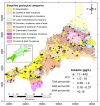Hazard Ranking Method for Populations Exposed to Arsenic in Private Water Supplies: Relation to Bedrock Geology
- PMID: 29194429
- PMCID: PMC5750908
- DOI: 10.3390/ijerph14121490
Hazard Ranking Method for Populations Exposed to Arsenic in Private Water Supplies: Relation to Bedrock Geology
Abstract
Approximately one million people in the UK are served by private water supplies (PWS) where main municipal water supply system connection is not practical or where PWS is the preferred option. Chronic exposure to contaminants in PWS may have adverse effects on health. South West England is an area with elevated arsenic concentrations in groundwater and over 9000 domestic dwellings here are supplied by PWS. There remains uncertainty as to the extent of the population exposed to arsenic (As), and the factors predicting such exposure. We describe a hazard assessment model based on simplified geology with the potential to predict exposure to As in PWS. Households with a recorded PWS in Cornwall were recruited to take part in a water sampling programme from 2011 to 2013. Bedrock geologies were aggregated and classified into nine Simplified Bedrock Geological Categories (SBGC), plus a cross-cutting "mineralized" area. PWS were sampled by random selection within SBGCs and some 508 households volunteered for the study. Transformations of the data were explored to estimate the distribution of As concentrations for PWS by SBGC. Using the distribution per SBGC, we predict the proportion of dwellings that would be affected by high concentrations and rank the geologies according to hazard. Within most SBGCs, As concentrations were found to have log-normal distributions. Across these areas, the proportion of dwellings predicted to have drinking water over the prescribed concentration value (PCV) for As ranged from 0% to 20%. From these results, a pilot predictive model was developed calculating the proportion of PWS above the PCV for As and hazard ranking supports local decision making and prioritization. With further development and testing, this can help local authorities predict the number of dwellings that might fail the PCV for As, based on bedrock geology. The model presented here for Cornwall could be applied in areas with similar geologies. Application of the method requires independent validation and further groundwater-derived PWS sampling on other geological formations.
Keywords: arsenic; environmental public health tracking; geology; hazard and exposure assessment; private water supplies; public health risk.
Conflict of interest statement
The authors declare no conflict of interest. PHE as the funding sponsors designed the study; funded the collection, analyses and interpretation of data; PHE funded the writing of the manuscript, and made the decision to publish the results.
Figures
Similar articles
-
Variability in the chemistry of private drinking water supplies and the impact of domestic treatment systems on water quality.Environ Geochem Health. 2016 Dec;38(6):1313-1332. doi: 10.1007/s10653-016-9798-0. Epub 2016 Jan 25. Environ Geochem Health. 2016. PMID: 26810082 Free PMC article.
-
Can arsenic occurrence rates in bedrock aquifers be predicted?Environ Sci Technol. 2012 Feb 21;46(4):2080-7. doi: 10.1021/es203793x. Epub 2012 Feb 9. Environ Sci Technol. 2012. PMID: 22260208 Free PMC article.
-
Arsenic contamination of drinking water in Ireland: A spatial analysis of occurrence and potential risk.Sci Total Environ. 2017 Feb 1;579:1863-1875. doi: 10.1016/j.scitotenv.2016.11.171. Epub 2016 Dec 6. Sci Total Environ. 2017. PMID: 27932216
-
A meta-analysis of the distribution, sources and health risks of arsenic-contaminated groundwater in Pakistan.Environ Pollut. 2018 Nov;242(Pt A):307-319. doi: 10.1016/j.envpol.2018.06.083. Epub 2018 Jun 28. Environ Pollut. 2018. PMID: 29990938 Review.
-
Arsenic in private drinking water wells: an assessment of jurisdictional regulations and guidelines for risk remediation in North America.J Water Health. 2014 Sep;12(3):372-92. doi: 10.2166/wh.2014.054. J Water Health. 2014. PMID: 25252340 Review.
Cited by
-
Advancing Global Health through Environmental and Public Health Tracking.Int J Environ Res Public Health. 2020 Mar 17;17(6):1976. doi: 10.3390/ijerph17061976. Int J Environ Res Public Health. 2020. PMID: 32192215 Free PMC article. Review.
-
Software application profile: the Rapid Inquiry Facility 4.0: an open access tool for environmental public health tracking.Int J Epidemiol. 2020 Apr 1;49 Suppl 1(Suppl 1):i38-i48. doi: 10.1093/ije/dyz094. Int J Epidemiol. 2020. PMID: 32293011 Free PMC article.
References
-
- Drinking Water Inspectorate (DWI) Drinking Water 2014: Private Water Supplies in England, July 2015. [(accessed on 7 June 2017)]; Available online: http://dwi.defra.gov.uk/about/annual-report/2014/pws-eng.pdf.
-
- Bartholomay R.C., Carter J.M., Qi S.L., Squillace P.J., Rowe G.L. Summary of Selected U.S Geological Survey Data on Domestic Well Water Quality for the Centers for Disease Control’s National Environmental Public Health Tracking Program. CDC Stacks; Atlanta, GA, USA: 2007. p. 57.
-
- Frisbie S.H., Mitchell E.J., Mastera L.J., Maynard D.M., Yusuf A.Z., Siddiq M.Y., Ortega R., Dunn R.K., Westerman D.S., Bacquart T., et al. Public health strategies for western Bangladesh that address arsenic, manganese, uranium, and other toxic elements in drinking water. Environ. Health Perspect. 2009;117:410–416. doi: 10.1289/ehp.11886. - DOI - PMC - PubMed
-
- Polya D.A., Middleton D.R.S. Arsenic in drinking water: Sources & human exposure routes. In: Bhattacharya P., Polya D.A., Jovanovic D., editors. Best Practice Guide on the Control of Arsenic in Drinking Water. IWA Publishing; London, UK: 2017. Chapter 1.
MeSH terms
Substances
LinkOut - more resources
Full Text Sources
Other Literature Sources
Medical
Molecular Biology Databases
Research Materials


